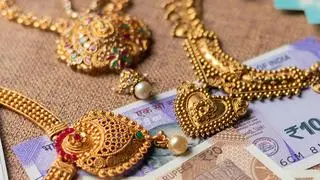[ad_1]

Jewellery retailers in India are reporting a significant surge in old gold exchanges, driven by record-high gold prices.
| Photo Credit:
PAUL NORONHA
With gold prices hovering above ₹95,000 per 10 grams and rising steadily over the past year, many consumers are opting to recycle or exchange their old jewellery rather than buy new. For people like Shweta (name changed), a Pune resident who recycles, and exchanges her gold annually, this is a more practical approach. “I wanted to get a new design in earrings or rings,” she shared. “But instead of buying something entirely new, which is more expensive now, I collect my old or broken jewellery and get something new made from it. It’s no longer scattered, and I end up with a beautiful, customised piece at a better price. I don’t have to pay much extra for it either.”
This shift in behaviour is being reflected in sales trends, with jewellers witnessing an uptick in old gold exchanges. According to World Gold Council data, gold recycling volumes grew from 350 tonnes in Q1 CY24 to 359 tonnes in Q4 CY25. Interestingly, Q1 CY25 saw a slight dip as some consumers chose to wait, anticipating even higher prices, said Sachin Jain Regional CEO India World Gold Council.
Suvankar Sen, MD & CEO of Senco Gold, noted that old gold exchanges, which contributed 25–30% of sales two years ago, have now surged to 40–45% in the past 3–4 months amid the high-price environment. “Only wedding customers are still going for heavier pieces,” he said.
C Vinod Hayagriv, Managing Director of C. Krishniah Chetty Group of Jewellers, shared that they’ve seen a 20–25% increase in both exchange and sale of old jewellery. Similarly, Titan’s jewellery division has recorded a 42–45% share of exchanges, a figure that’s been steadily rising year-on-year. “Even the exchange of non-tarnished gold has been creeping up,” said Ajoy Chawla, CEO of Titan’s Jewellery Division.
The uptick in old jewellery is not just limited to old jewellery exchanges is not just a retail trend it also affects sourcing. “It serves as a second source of raw material,” explained Hayagriv. “We do incur costs in processing, refining, melting losses, and delays. But since the ready jewellery gets sold through exchange, our inventory turn improves. So far, it’s a healthy balance, despite the added costs.”
Echoing this sentiment, Varghese Alukkas, Managing Director of JOS Alukkas, said “The amount we need to bring in from external suppliers has come down as more customers bring in old gold,” said Alukkas. “It’s not only influencing how we manage sourcing but also how we plan our manufacturing cycles.”
However, he also pointed out that a decline in outright gold sales means there’s less recycled gold flowing in directly, which impacts sourcing dynamics. “The increase in exchanges has helped us maintain a steady inflow of gold that can be refined and reused. It has prompted us to think more strategically about procurement, balancing exchange inflows with market sourcing for long-term cost efficiency.”
While sales have dipped in tier-2 and tier-3 cities—largely due to stagnant agricultural income—Sen remains optimistic. “After a good monsoon, we expect sales to pick up,” he projected.
(Report filed by BL intern Nethra Sailesh)
More Like This

Published on May 6, 2025
[ad_2]
Source link


